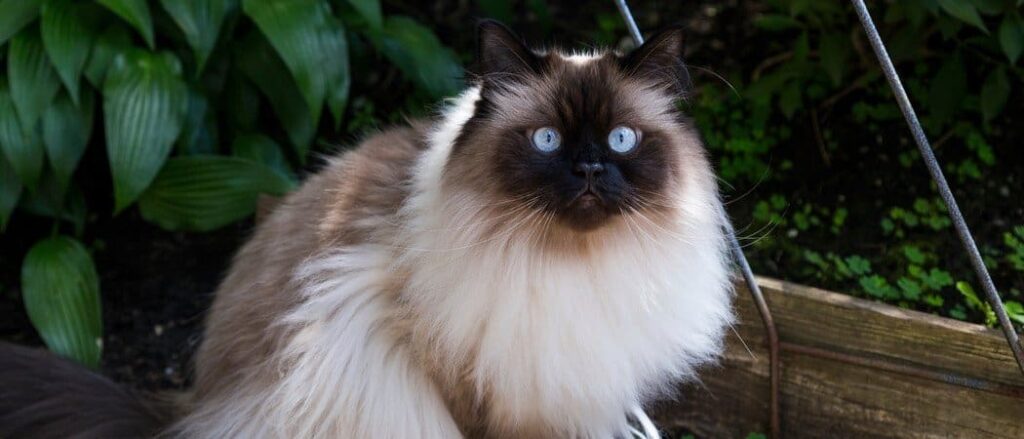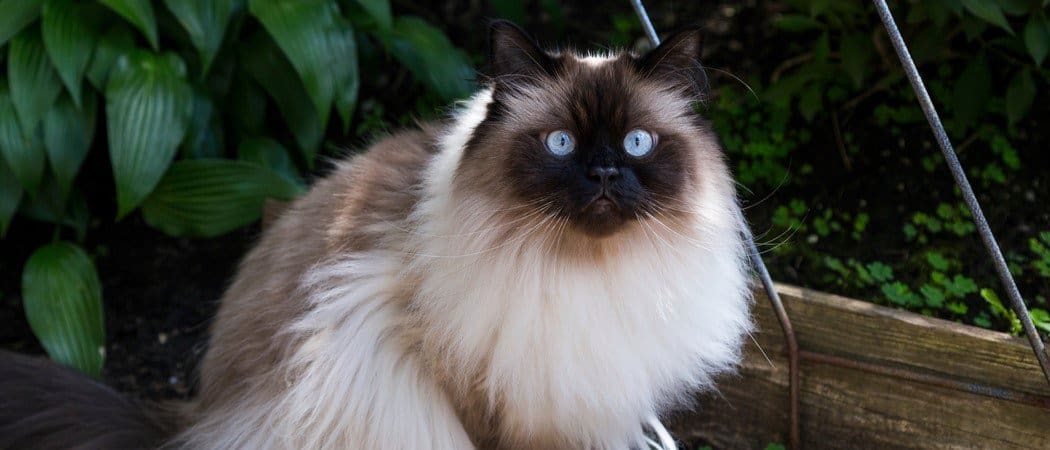Imagine being greeted by a Himalayan Persian cat, its elegant and regal presence catching your eye. But what truly captures your attention is its luxurious and plush coat, adorned with a myriad of captivating colors. The immaculate fur feels soft to the touch, exuding a sense of opulence and refinement. In this article, we will explore the enchanting world of the Himalayan Persian cat’s coat, diving into its origins, characteristics, and the care it demands. Get ready to be captivated by the beauty and grandeur of these majestic felines.
The Luxurious and Plush Coat of Himalayan Persian Cats
Introduction
Himalayan Persian cats are known for their stunning and luxurious coats that make them truly stand out among other cat breeds. The combination of their Persian ancestry and the color-point patterns of Siamese cats gives them a unique and regal appearance. In this article, we will explore the characteristics of a Himalayan Persian cat’s coat, the different color varieties, grooming requirements, proper bathing techniques, tips for managing tangles and mats, and how to maintain the luster and shine of their coat. Whether you own a Himalayan Persian cat or are simply fascinated by their beautiful coats, this article will provide you with all the information you need to keep their coat healthy and beautiful.
Characteristics of a Himalayan Persian Cat’s Coat
Long and Dense Fur
One of the most noticeable features of a Himalayan Persian cat is their long and dense fur. Their double coat consists of a long, soft topcoat that gives them their signature plush appearance. This dense fur helps to keep them warm during colder months and adds to their overall elegance.
Silky Texture
Not only is the fur long and dense, but it also has a silky texture that is incredibly soft to the touch. It’s no wonder that Himalayan Persian cats are often described as having a luxurious coat. Running your fingers through their fur is a delight, and their silky coat makes them irresistible to cuddle with.
Thick Undercoat
Beneath the long topcoat, Himalayan Persian cats have a thick undercoat that provides additional insulation. This undercoat helps to regulate their body temperature and keep them comfortable in various weather conditions. The combination of the topcoat and undercoat gives their fur added volume and depth.
Pronounced Ruff
One of the most distinctive features of a Himalayan Persian cat’s coat is the pronounced ruff, also known as a “mane.” This extra fur around their neck gives them a regal and majestic appearance, reminiscent of a lion’s mane. The ruff adds to their overall beauty and makes them even more captivating.
Fluffy Tail
In addition to their long and plush body fur, Himalayan Persian cats also have a fluffy tail that completes their elegant look. The tail is just as soft and silky as the rest of their coat, and it often accentuates their graceful movements. Watching a Himalayan Persian cat swish its fluffy tail is truly a sight to behold.
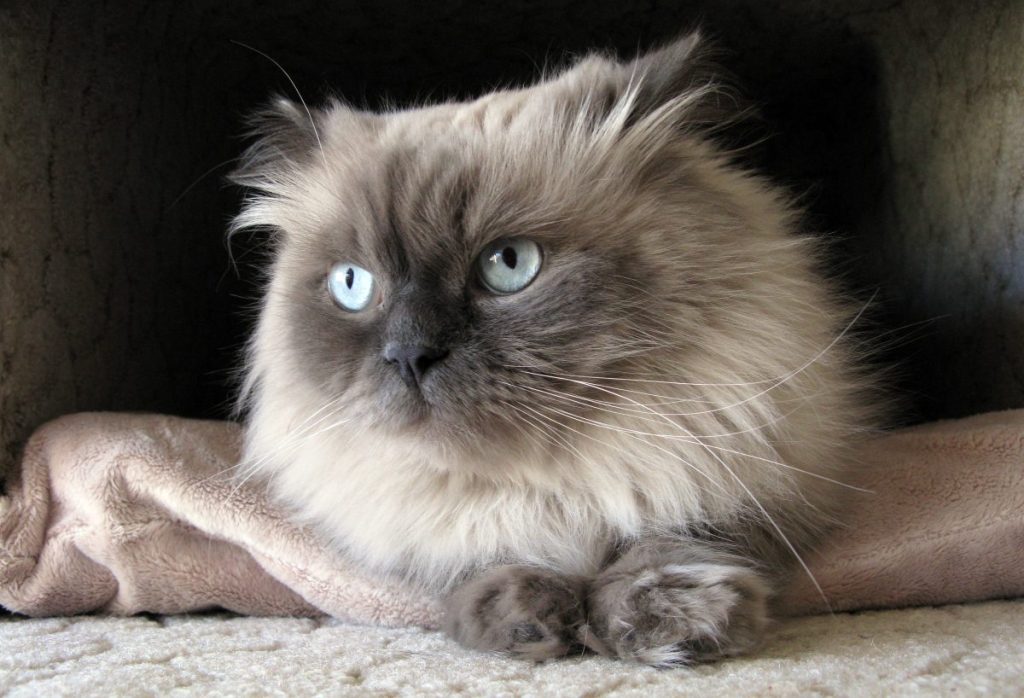
Color Varieties in Himalayan Persian Cats
Himalayan Persian cats are known for their stunning color point patterns, which are the result of their Siamese ancestry. These cats have a lighter body color that gradually darkens on their extremities, such as their ears, face, paws, and tail. Here are some of the different color varieties you may find in Himalayan Persian cats:
Traditional Color Point Patterns
The traditional color point patterns seen in Himalayan Persian cats include seal point, blue point, chocolate point, and lilac point. These patterns have been around for decades and are beloved by cat enthusiasts all over the world. Each pattern has its own unique beauty and charm.
Tabby Points
In addition to the traditional color point patterns, Himalayan Persian cats can also have tabby points. Tabby points add a playful and whimsical element to their coat, with distinct stripes or swirls on their ears, face, and tail. This variation adds a touch of uniqueness to an already striking coat.
Tortie Points
Tortie points refer to the combination of color points and tortoiseshell markings in a Himalayan Persian cat’s coat. This creates a stunning blend of colors, with patches of red or cream mixed with darker shades. The tortie points add a vibrant and lively element to the coat, making each cat truly one-of-a-kind.
Color Point Carriers
Not all Himalayan Persian cats have visible color points, but they can still carry the color point gene. These cats may have a solid coat color, such as white, cream, or fawn, but can produce offspring with color point patterns when bred with another Himalayan Persian or a Siamese cat. Color point carriers are important for maintaining color diversity within the breed.
Points vs. Solid Colors
The distinction between points and solid colors in Himalayan Persian cats is important to understand. Points refer to the darker coloration on the ears, face, paws, and tail, while the rest of the body is lighter. Solid colors, on the other hand, have a consistent coloration throughout their entire coat. Both variations are equally beautiful and have their own appeal.
Rare and Exotic Coat Colors
In addition to the more common color varieties, Himalayan Persian cats can also have rare and exotic coat colors that are highly sought after by enthusiasts and collectors. These include shades like red, cream, lynx (striped tabby), and even silver or golden varieties. These rare colors make each cat a true treasure and add to their overall allure.
Grooming Requirements for Himalayan Persian Cats
While the beautiful coat of a Himalayan Persian cat is certainly a sight to behold, it also requires regular grooming to keep it healthy and tangle-free. Here are some important grooming requirements to keep in mind:
Daily Brushing
One of the key steps in maintaining a Himalayan Persian cat’s coat is daily brushing. Their long and dense fur is prone to tangling and matting, so regular brushing is essential to prevent these issues. Using a wide-toothed comb or a soft-bristled brush, gently remove any tangles or knots from their fur.
Preventing Matting
Matting can occur if the coat is not properly cared for, and it can be painful and uncomfortable for the cat. To prevent matting, pay special attention to areas prone to tangling, such as behind the ears, under the chin, and along the belly. Regular brushing will reduce the likelihood of mats forming.
Trimming the Fur
Trimming the fur of a Himalayan Persian cat is another important grooming technique. While you don’t need to give them a full haircut like some other breeds, trimming their fur around the anus and paw pads can help to maintain hygiene and prevent matting in those areas. Always use sharp, pet-safe scissors and exercise caution while trimming.
Cleaning the Eyes and Ears
Himalayan Persian cats are known for their beautiful blue eyes, but those gorgeous eyes can also be prone to tear stains. Regularly cleaning their eyes with a damp cloth or a gentle eye cleanser can help to prevent staining. Additionally, check their ears regularly for wax buildup and gently clean them with a vet-approved ear cleaning solution if necessary.
Maintaining Hygiene
Good hygiene is essential for a healthy and beautiful coat. This includes keeping the litter box clean to prevent any soiling on their fur, regularly checking for fleas or ticks, and providing a balanced diet to promote overall coat health. A clean and well-groomed Himalayan Persian cat is a happy and confident cat.
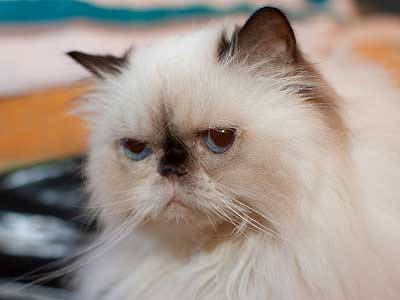
Proper Bathing Techniques for Himalayan Persian Cats
While Himalayan Persian cats are generally known to be clean animals that groom themselves, they can still benefit from occasional baths to keep their coat in optimal condition. Here are some proper bathing techniques to follow:
Choosing the Right Shampoo for Himalayan Persian Cats
When bathing a Himalayan Persian cat, it’s important to select a high-quality and gentle shampoo specifically formulated for cats. Avoid using human shampoos, as they can be too harsh for their sensitive skin. Look for shampoos that are moisturizing, hypoallergenic, and pH-balanced for feline use.
Preparing the Cat for Bathing
Before beginning the bathing process, make sure to gather all the necessary supplies and prepare a safe and comfortable bathing area. Fill a sink or a basin with warm water, place a non-slip mat at the bottom to prevent accidents, and have towels, shampoo, and a gentle sprayer or pitcher nearby. Also, trim your cat’s nails beforehand to minimize scratches.
Wetting and Lathering the Coat
Begin the bathing process by wetting your Himalayan Persian cat’s coat with warm water. Use the sprayer or a pitcher to pour water over their body, avoiding their face and ears. Gently massage the shampoo into their fur, making sure to create a rich lather. Be careful not to get shampoo in their eyes or ears.
Rinsing and Drying the Coat
Thoroughly rinse your cat’s fur, making sure to remove all traces of shampoo. Rinse using the sprayer or a pitcher, ensuring that the water temperature is warm but not too hot or cold. Once the coat is rinsed, gently pat them dry with a soft towel. Avoid vigorous rubbing, as it can cause tangling or damage to the fur.
Post-Bathing Care
After the bath, allow your Himalayan Persian cat to air dry in a warm and draft-free room. It’s important to keep them warm during the drying process, so consider using a pet-safe heating pad or placing them near a warm air vent. Once their fur is completely dry, take the time to brush their coat to prevent tangles.
Managing Tangles and Mats in Himalayan Persian Cats’ Coats
Despite regular grooming and proper bathing techniques, tangles and mats may still occur in a Himalayan Persian cat’s coat. Here are some tips for managing and dealing with them:
Identifying and Preventing Tangles and Mats
Early detection is key when it comes to managing tangles and mats in your cat’s coat. Regularly inspect their fur while grooming and be on the lookout for any knots or clumps that may have formed. By catching them early, you can prevent them from worsening and becoming more difficult to remove.
Safe and Effective Detangling Methods
If you discover a tangle or mat in your Himalayan Persian cat’s coat, it’s important to approach the detangling process with care. Start by gently working through the tangle with your fingers, trying to separate the hairs without causing any discomfort to your cat. If the tangle is stubborn, you can use a wide-toothed comb or a detangling spray to help loosen it.
Dealing with Stubborn Mats
Stubborn mats can be more challenging to remove and may require extra patience and gentle handling. If the mat is small and not too tightly matted, you can try using a comb to carefully untangle the hairs. However, for larger mats or mats that are close to the skin, it’s best to seek the help of a professional groomer or a veterinarian to avoid causing any harm to your cat’s skin.
Avoiding Coat Damage during Mat Removal
When removing tangles or mats, it’s important to be extremely cautious to avoid damaging your Himalayan Persian cat’s delicate skin. Use gentle pressure and avoid pulling or tugging forcefully on the hair. If you are unsure or uncomfortable with removing mats yourself, it’s best to consult a professional who has experience in dealing with such situations.
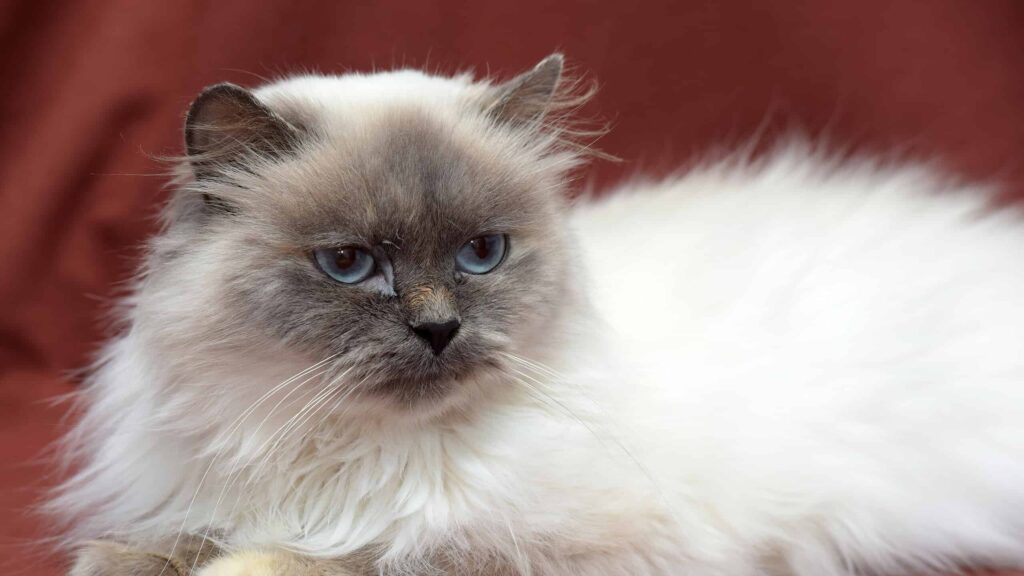
Maintaining the Luster and Shine of a Himalayan Persian Cat’s Coat
To keep your Himalayan Persian cat’s coat looking its best, it’s important to focus not only on grooming but also on overall coat health. Here are some tips for maintaining the luster and shine of their coat:
Proper Nutrition for Healthy Coat
A healthy diet plays a crucial role in promoting a shiny and lustrous coat. Make sure to provide your Himalayan Persian cat with balanced and high-quality cat food that is rich in essential nutrients, such as omega-3 fatty acids, vitamins, and minerals. Consult with your veterinarian to determine the best diet for your cat’s specific needs.
Hydration and Moisture Balance
Hydration is essential for maintaining a healthy coat, so make sure your cat has access to fresh water at all times. Dry or dehydrated skin can lead to a dull and lackluster coat. Additionally, consider using a humidifier in your home, especially during dry winter months, to help maintain the moisture balance in the air and prevent dry skin.
Supplements for Coat Health
In addition to a balanced diet, certain supplements can further enhance the health and appearance of your Himalayan Persian cat’s coat. Omega-3 fatty acids, such as fish oil, can promote coat health and reduce inflammation. Always consult with your veterinarian before adding any supplements to your cat’s diet.
Skin and Coat Care
Regularly check your Himalayan Persian cat’s skin and coat for any signs of dryness, redness, or irritation. Excessive scratching or biting can indicate underlying skin issues that need to be addressed. If you notice any concerns, seek veterinary advice to ensure the health of your cat’s coat.
Regular Brushing and Grooming
Consistency is key when it comes to maintaining the luster and shine of your Himalayan Persian cat’s coat. Dedicate time each day to brush their fur and remove any loose hairs or tangles. Not only will this keep their coat looking its best, but it will also strengthen the bond between you and your cat.
Best Products and Tools for Grooming a Himalayan Persian Cat
To ensure effective and gentle grooming sessions for your Himalayan Persian cat, it’s important to have the right products and tools on hand. Here are some recommendations:
Brushes and Combs for Long-Haired Breeds
Invest in high-quality brushes and combs specifically designed for long-haired breeds like Himalayan Persian cats. Look for brushes with soft bristles and wide-toothed combs that can easily glide through their fur without causing any discomfort. Brushes with anti-static properties are also beneficial in preventing static electricity in their coat.
Detangling Sprays and Conditioners
Detangling sprays and conditioners can be a lifesaver when dealing with stubborn tangles and mats. Look for products that are specially formulated for cats and have moisturizing properties to help soften the hair and make it easier to untangle. Always follow the instructions on the product label and use them sparingly to avoid making the coat greasy.
Shampoos and Cleansers
Choose gentle and cat-specific shampoos and cleansers that are suitable for Himalayan Persian cats. Opt for products that are hypoallergenic, pH-balanced, and free from harsh chemicals that can irritate their sensitive skin. Some shampoos also offer additional benefits, such as moisturizing properties or tear stain removal.
Grooming Gloves and Mitts
Grooming gloves and mitts are a great tool for removing loose hair and gently massaging your cat’s coat. The soft rubber tips on these gloves effectively capture and remove loose fur while giving your cat a pleasant massage. Cats often enjoy the sensation of being groomed with gloves or mitts, making the grooming process more enjoyable for both of you.
Professional-Grade Tools for Show Cats
For Himalayan Persian cats that participate in cat shows, professional-grade tools may be necessary to achieve the highest level of grooming. These can include high-quality scissors for precision trimming, specialized combs for show-quality grooming, and professional grooming tables and arm restraints to ensure safety during grooming sessions. Always consult with experienced breeders or groomers for personalized recommendations.
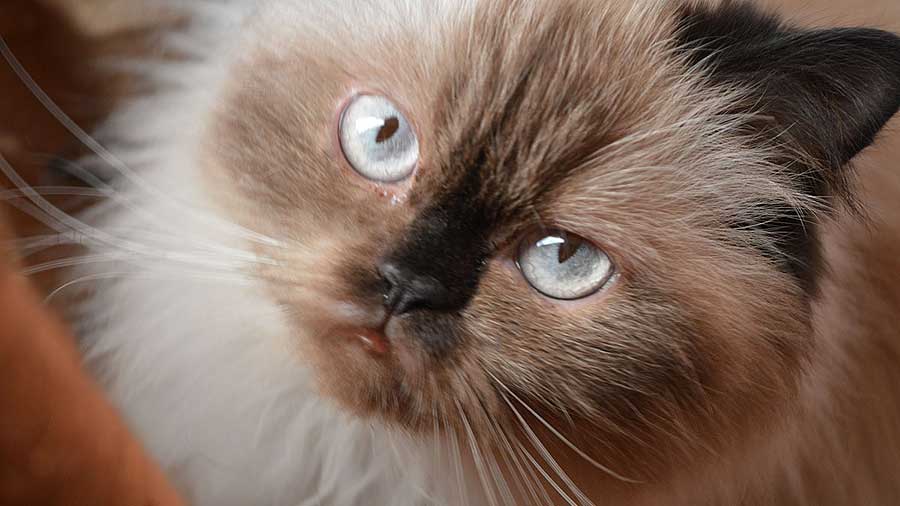
Professional Grooming Options for Himalayan Persian Cats
While regular at-home grooming is crucial for a Himalayan Persian cat’s coat, there may be instances where professional grooming is necessary or preferred. Here are some benefits, considerations, and options for professional grooming:
Benefits of Professional Grooming
Professional grooming can provide several benefits for both you and your Himalayan Persian cat. Groomers are trained in handling and grooming cats and can ensure a stress-free and comfortable experience for your cat. They have the skills and expertise to address any specific coat or skin issues and can leave your cat looking its best.
Finding a Qualified Cat Groomer
When selecting a professional groomer for your Himalayan Persian cat, it’s important to choose someone with experience in grooming long-haired cat breeds. Ask for recommendations from trusted sources, such as your veterinarian, local cat clubs, or fellow cat owners. Don’t be afraid to ask the groomer about their qualifications, experience, and handling techniques.
What to Expect During a Professional Grooming Session
During a professional grooming session, the groomer will likely perform a thorough brushing and combing to remove any tangles or loose hair. They may also offer additional services, such as bathing, drying, trimming, and even specialized grooming techniques like lion cuts. The details of the grooming session will depend on your specific needs and preferences.
Potential Challenges and Risks of Professional Grooming
While professional grooming can be beneficial, it’s important to be aware of potential challenges and risks. Some cats may become stressed or anxious during grooming sessions, especially if they are not accustomed to being handled by unfamiliar people. Additionally, it’s important to communicate your expectations and any specific concerns regarding your cat’s coat or grooming preferences to the groomer to ensure a satisfactory outcome.
Tips for Keeping a Himalayan Persian Cat’s Coat Healthy and Beautiful
To maintain a healthy and beautiful coat for your Himalayan Persian cat, consider the following tips:
Regular Maintenance and Grooming Schedule
Establish a consistent maintenance and grooming schedule for your Himalayan Persian cat. Daily brushing, regular bathing as needed, and periodic inspections for tangles or mats will help keep their coat in optimal condition. Regular grooming sessions also provide an opportunity for you to bond with your cat and keep a close eye on their overall health.
Creating a Comfortable Grooming Environment
Make grooming sessions a positive and comfortable experience for your Himalayan Persian cat by creating a calm and inviting environment. Choose a quiet space where you can both relax and minimize distractions. Use soft blankets or towels as a comfortable grooming surface, and provide treats or rewards to make the experience enjoyable for your cat.
Building Trust and Bonding during Grooming
Grooming is not only about maintaining your cat’s coat but also about building trust and strengthening your bond. Approach grooming sessions with patience, love, and a gentle touch. Speak to your cat in a soothing tone and offer praise and rewards for good behavior. Over time, grooming can become a peaceful and enjoyable activity for both of you.
Addressing Hairballs and Shedding
Himalayan Persian cats are prone to hairballs due to their long fur and grooming habits. Help prevent the formation of hairballs by regular brushing to remove loose hair. Additionally, consider adding hairball prevention products or supplements to your cat’s diet, as recommended by your veterinarian. Be prepared for shedding, especially during seasonal changes, and regularly clean up loose fur to maintain a clean environment.
Seeking Veterinary Advice for Coat Concerns
If you notice any significant changes or concerns with your Himalayan Persian cat’s coat, such as excessive shedding, severe matting, skin irritation, or hair loss, it’s important to seek veterinary advice promptly. Some coat issues may be indicative of underlying health conditions or allergies that require medical attention. Your veterinarian is the best resource to diagnose and address any concerns related to your cat’s coat.
Now that you have a comprehensive understanding of the luxurious and plush coat of Himalayan Persian cats, you can confidently care for and maintain your cat’s beautiful coat. By following proper grooming techniques, addressing tangles and mats promptly, and prioritizing overall coat health, your Himalayan Persian cat will continue to captivate with its stunning appearance. Enjoy the bonding moments and the joy that comes with pampering and caring for your furry companion.
Common Questions and Answers:
-
Q: How often should I brush my Himalayan Persian cat’s coat? A: Daily brushing is ideal for maintaining a Himalayan Persian cat’s coat and preventing tangles or mats.
-
Q: Can I use human shampoo to bathe my Himalayan Persian cat? A: No, it’s best to use gentle and cat-specific shampoos formulated for their sensitive skin.
-
Q: How can I prevent tear stains on my Himalayan Persian cat’s fur? A: Regularly clean their eyes with a damp cloth or a gentle eye cleanser to prevent tear stains from forming.
-
Q: How do I remove tangles or mats from my Himalayan Persian cat’s coat? A: Use gentle pressure and detangling products, or seek the help of a professional groomer for stubborn mats.
-
Q: Is professional grooming necessary for a Himalayan Persian cat? A: Professional grooming can be beneficial, especially for breed standards and specific coat or skin issues, but regular at-home grooming is essential.
-
Q: What should I do if my Himalayan Persian cat develops excessive shedding? A: Excessive shedding can be a sign of an underlying health issue, so it’s best to consult with a veterinarian for proper evaluation and advice.
-
Q: Can I trim my Himalayan Persian cat’s fur at home? A: While trimming the fur around the anus and paw pads can be done at home, it’s best to consult with a professional groomer for any advanced trimming needs.
-
Q: How can I prevent my Himalayan Persian cat from developing hairballs? A: Regular brushing to remove loose hair, adding hairball prevention products or supplements to their diet, and ensuring hydration can help prevent hairball formation.
-
Q: Are there any specific grooming products recommended for Himalayan Persian cats? A: Look for grooming products specifically designed for long-haired breeds, such as gentle brushes, detangling sprays, and cat-specific shampoos.
-
Q: What should I do if my Himalayan Persian cat’s coat looks dull or lacks shine? A: Ensure a balanced diet, maintain hydration, consider supplements for coat health, and consult with a veterinarian if you notice persistent coat issues.
